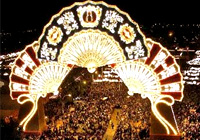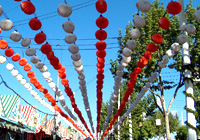The Feria de Abril in Seville is, without a doubt, one of the highlights of the cultural agenda not only of the city but of the entire country. It's an incredible time of year to be in Andalucía, and we encourage you to take advantage of it and experience the Feria for yourself! For this very reason, Enforex schools stay open all year round. That way, if you want to study Spanish in Seville, you can do so while also discovering this wonderful celebration of music, food, flamenco and life!
While there's nothing quite like experiencing this celebration for yourself, read on for all sorts of background information about the Feria de Abril.
When and Where is the Feria de Abril?
Two weeks after the processions of Semana Santa come to an end, the atmosphere brims with the color, music, and merriment of the Feria de Abril. Given that Easter itself is a moveable feast, the dates of the April fair of Seville are not fixed, either, although you can be certain that it will take place sometime between the first week of April and the beginning of May. Meant as a tribute of sorts to the arrival of spring, similar fairs are held all over the country during the early days of the blossoming season. Nevertheless, Seville's is the undisputed king of them all.


Feria de Abril Traditions
With the quick flick of a switch, over 22,000 bulbs bathe Seville's expansive fairgrounds in joyful light. This first night of the April fair of Seville, the Alumbrao, features the brilliant lights adorning the fairgrounds and the massive main gate – designed and constructed anew each year – as they flicker to life for the first time of the year, marking the beginning of a week of dancing, music, and basking in the joyous Sevillian culture. This week also sees the best bullfights of the season, so be sure to bring your white handkerchief and follow the Sevillians to the Maestranza bullring. ¡Olé!
Pass through the towering gate into the festive realm of the Feria de Abril and you'll see over 1000 striped casetas (tents) lining both sides of the streets. These casetas constitute an intrinsic part of the tradition of the fair and give the celebration its particular color – quite literally! Owned by groups of friends, families, organizations, or political parties, they serve as miniature homes, intimately decorated by their owners and equipped with a kitchen, a bar, and tables and chairs for enjoying scrumptious tapas and wine.
The lively songs coming from within each caseta during the April fair of Seville are sevillanas, four-part songs with accompanying four-part dances that Sevillians begin learning as soon as they take their first steps as children. The bright, polka-dotted flamenco dresses of the women, the men on horseback donning traditional clothing of farm-workers, and groups getting out of adorned horse-drawn carriages complete the atmosphere with a unique air of tradition that the cheerful Sevillians are happy to show off.
Instead of slowly winding down, the Feria de Abril concludes with a literal bang as fireworks launch into the sky in Seville's spectacular fireworks display.
History of the Feria de Abril
The Feria de Abril certainly didn't begin as the sensational fiesta we see today. Instead of polka-dot dresses swirling to lively music there was cattle. It began in 1847 as a livestock and agriculture fair, evolving over the years into a purely Sevillian tradition. Erected tents, which eventually led to the casetas lining the current grounds, served to keep businessmen cool beneath the scorching sun, and small food stands slowly began setting up camp at the fairgrounds.
Soon, Sevillians began flocking to the fair, and in their larger-than-life manner made it their own. Eventually, the livestock stalls phased out and the festival began to turn more and more into an occasion to eat, drink, dance, and have a fantastic time. As a result, the Feria de Abril grew exponentially over the years, to the point where the original fairgrounds just weren't big enough. These days, the April fair of Seville boasts its own fairgrounds, specifically allocated for the celebration and used only during this special week.




